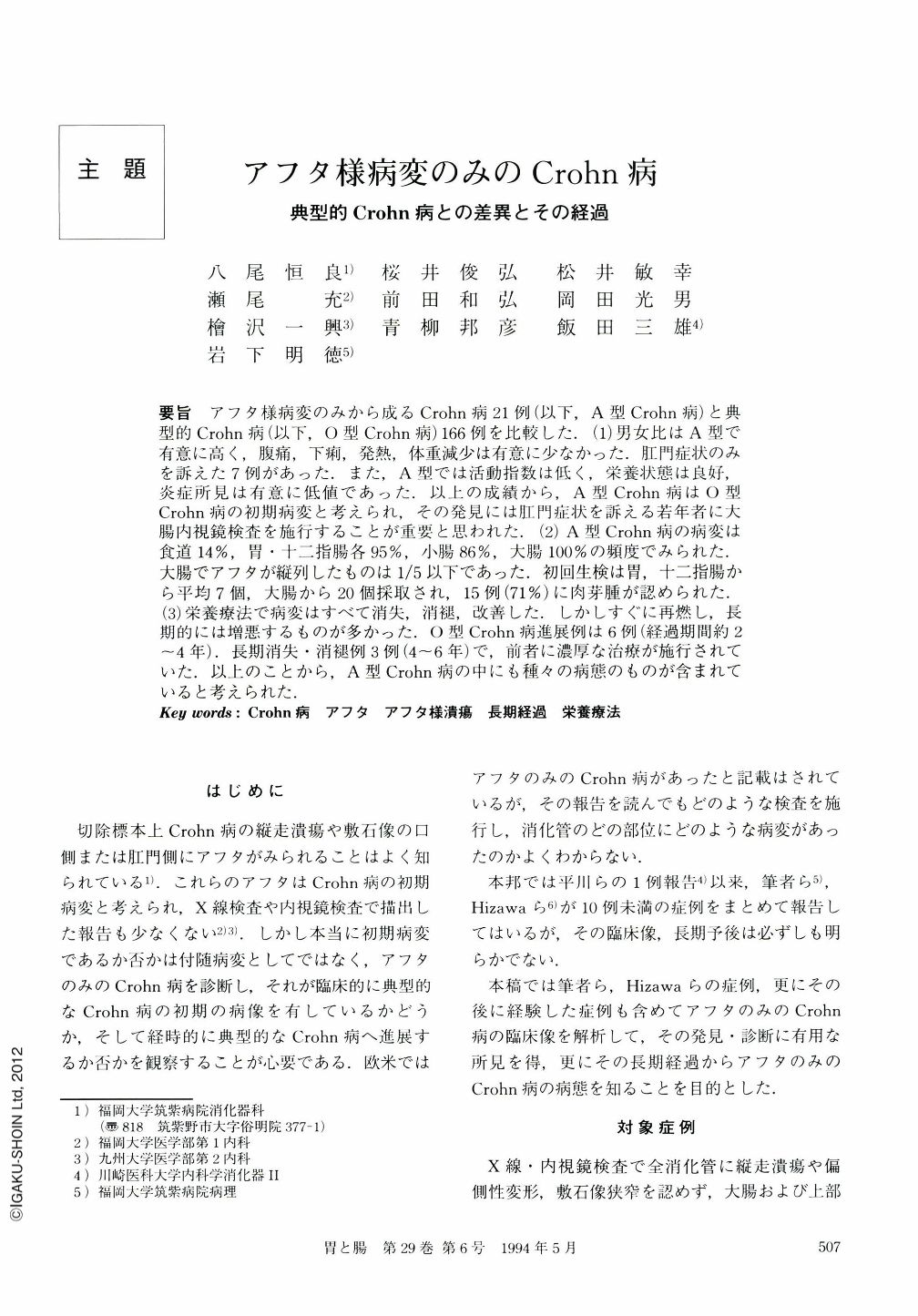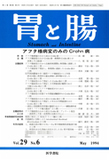Japanese
English
- 有料閲覧
- Abstract 文献概要
- 1ページ目 Look Inside
- サイト内被引用 Cited by
要旨 アフタ様病変のみから成るCrohn病21例(以下,A型Crohn病)と典型的Crohn病(以下,O型Crohn病)166例を比較した.(1)男女比はA型で有意に高く,腹痛,下痢,発熱,体重減少は有意に少なかった.肛門症状のみを訴えた7例があった.また,A型では活動指数は低く,栄養状態は良好,炎症所見は有意に低値であった.以上の成績から,A型Crohn病はO型Crohn病の初期病変と考えられ,その発見には肛門症状を訴える若年者に大腸内視鏡検査を施行することが重要と思われた.(2)A型Crohn病の病変は食道14%,胃・十二指腸各95%,小腸86%,大腸100%の頻度でみられた.大腸でアフタが縦列したものは1/5以下であった.初回生検は胃,十二指腸から平均7個,大腸から20個採取され,15例(71%)に肉芽腫が認められた.(3)栄養療法で病変はすべて消失,消褪,改善した.しかしすぐに再燃し,長期的には増悪するものが多かった.O型Crohn病進展例は6例(経過期間約2~4年).長期消失・消褪例3例(4~6年)で,前者に濃厚な治療が施行されていた.以上のことから,A型Crohn病の中にも種々の病態のものが含まれていると考えられた.
Twenty one cases of Crohn's disease exclusively composed of aphthas (type A Crohn's disease) were analyzed in comparison with 166 cases of typical Crohn's disease (type O Crohn's disease).
Type A Crohn's disease had significantly higher male/female ratio and lower incidence of abdominal pain, diarrhea, fever, and loss of weight than type O Crohn's disease. Seven patients with type A Crohn's disease complained of anal symptoms. Type A Crohn's disease patients usually had lower activity index and preserved good nutritional condition and significantly loweri nflammatory signs on laboratory examinations. These results suggested that type A Crohn's disease might be an early stage of type O Crohn's disease and it would be important to perform colonoscopic examination in young patients with anal symptoms to detect type A Crohn's disease.
The location and incidence of lesions of type A Crohn's disease were as follows; the esophagus 14%, stomach and duodenum 95%, small intestine 86%, large intestine 100%. Only less than a fifth cases had longitudinally aligned aphthas in the large intestine. In the initial endoscopic biopsy examinations, seven pieces of specimen from the stomach and duodenum, 20 pieces of specimen from large intestine were taken on the average, granulomatous lesions were found in 15 cases (71%).
The nutritional therapy remitted and/or cured two lesions, but recurred shortly and deteriorated in the long run. Six cases progressed to type O Crohn's disease (about two to four years after the initial diagnosis), three cases has been remitted for a long time (four to six years). The former cases had received intensive treatments. These results suggest that type A Crohn's disease may contain different stages and pathophysiology of the disease.

Copyright © 1994, Igaku-Shoin Ltd. All rights reserved.


